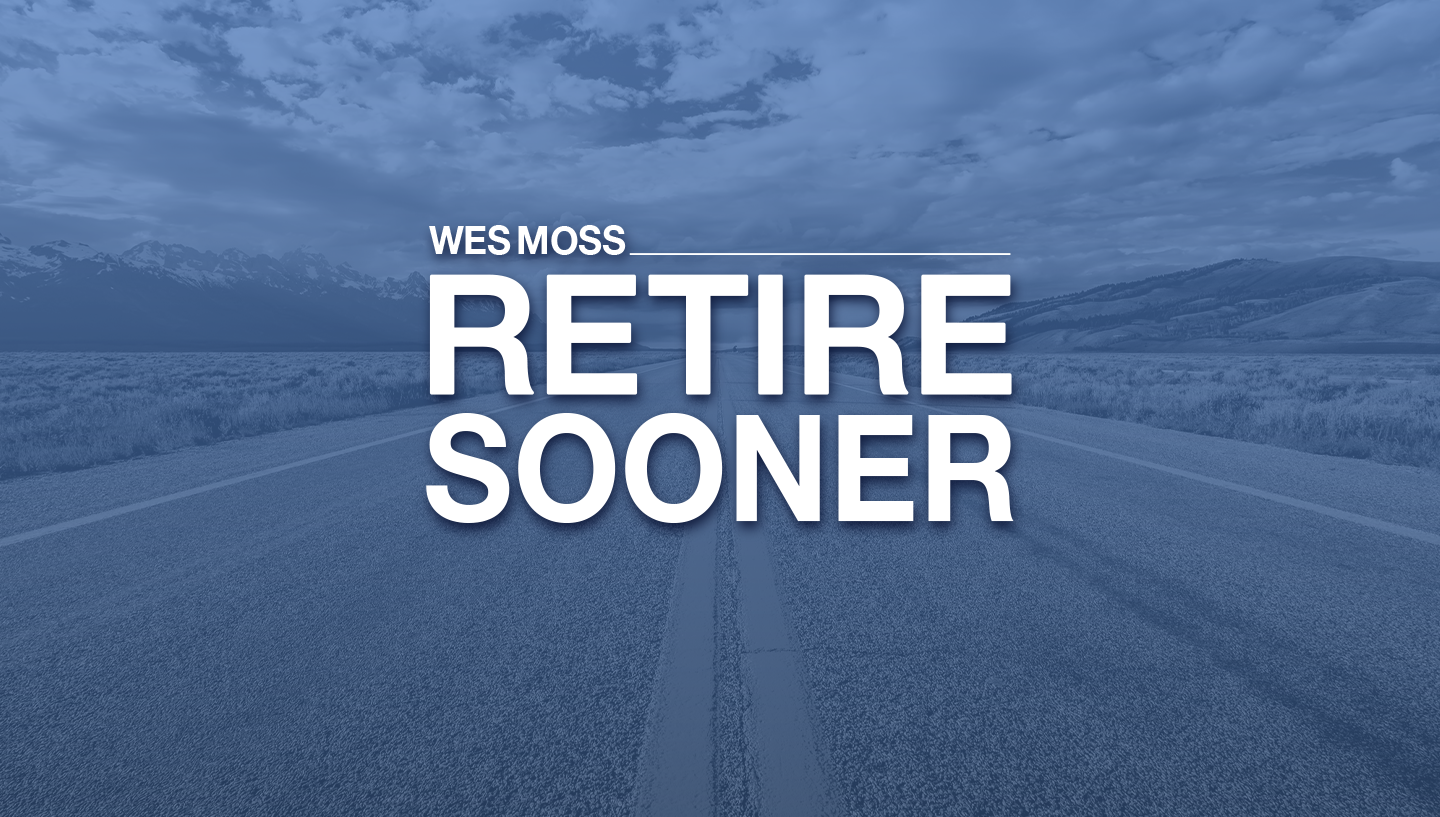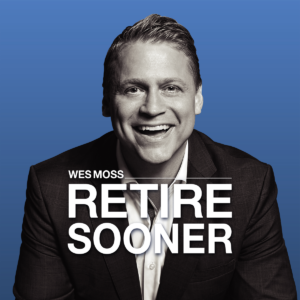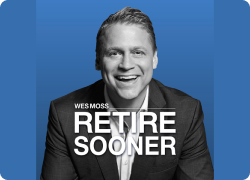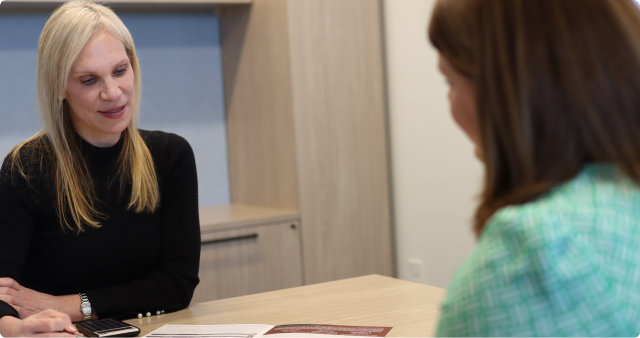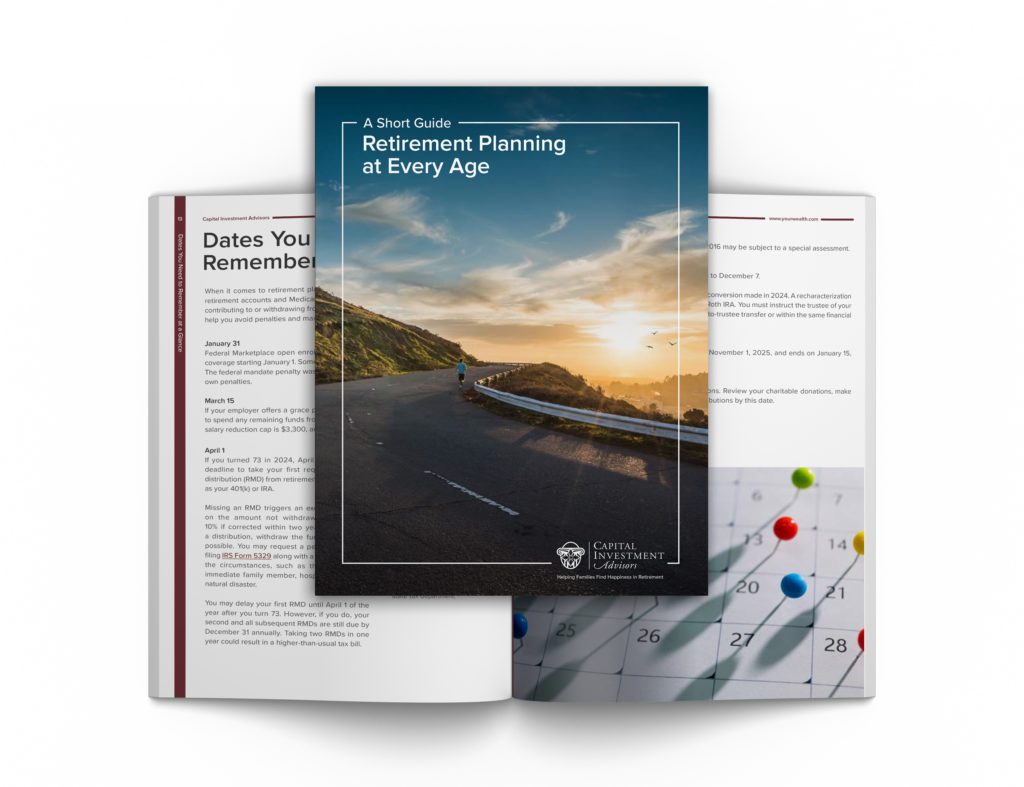Tackle the million-dollar retirement question: How much is enough? Use Wes’s “Fill the Gap” (FTG) method to simplify retirement math—subtract guaranteed income like Social Security from your monthly spending goal and multiply the shortfall by 25 to calculate target savings. Explore other early retirement strategies, including the debate about lump sum buyouts vs. pensions, and weigh real estate against dividend-yielding ETFs for passive income. Finally, join Wes and Christa for a candid discussion about financial media scare tactics and why staying the course typically beats chasing headlines.
Read The Full Transcript From This Episode
(click below to expand and read the full interview)
- Christa DiBiase [00:00:51]:
I’m excited about today’s show.Wes Moss [00:00:53]:
I know. Hopefully we’ve got questions flooding in.Christa DiBiase [00:00:56]:
We do. We definitely have a lot of questions. But I hear the first thing you’re going to talk about is something we’re all wondering. How do you figure out how much you need for retirement?Wes Moss [00:01:05]:
You know, I think that even if you know how much you need for retirement, you don’t think about it every day. So you kind of forget. So you might do it, and then you think, six months, like, wait a minute, how much do I need for retirement? And then you do it again. You think, okay, I got it. For some reason, it’s because we’re not focusing on it all the time. You can. You can lose track. And then when you lose track of how much you need, there’s a little uncertainty.Wes Moss [00:01:29]:
And financial planning is tough and investing is really tough when you’re uncertain. So it’s always good to kind of have this certainty around the goal. Here’s my goal.Christa DiBiase [00:01:37]:
I always panic, too, because I think, what if I’m wrong?Wes Moss [00:01:40]:
You need.Christa DiBiase [00:01:41]:
I don’t know. That’s the thing. I want to hear what you have to say. But I know I’ve thought I had a number in mind, like, say, 10 years ago. And then I’m like, wait, is that number really going to be big enough? Inflation. You know, it just. So I’m.Wes Moss [00:01:53]:
So there’s a practical way. This is, I think, a simple way. There’s. I’m going to share two really, let’s call it straightforward ways. Some people really like this. I think it’s super simple. But I brought up this concept in one of my earlier books. You can retire sooner than you think, called filling the gap.Wes Moss [00:02:12]:
And then it became ftg. And then it. And then I have folks that I’ve worked with over the years send me these spreadsheets and they’ll say, this is my FTG analysis. It’s because it’s a really nice easy way to remember how much you will need and then how much you’ll need to spend. So we’re going to start with some spending numbers, some income numbers, which then rolls up to the big picture number of how much you’ll need in savings to fund all that. So this is how FTG works. We start filling the gap. We start with what you know, that will be steady in retirement.Wes Moss [00:02:44]:
So we start with our income streams. We’re going to start with Social Security. Maybe you have some sort of pension or maybe your spouse has a pension. So let’s just give a, a round number here to, to start out, imagine you and your spouse each get $2,000. For social, that’s four, and somebody gets a thousand. So now in a pension, that’s 5k a month, okay? And you look out five years and you look at what you’re spending right now and you think, well, I’m spending $7,000 a month today, but in retirement I might need 8,000 for some cushions, some travel, some inflation. So you set a goal, a spending goal of $8,000 a month. So we take 8,000, which is the need, minus the guaranteed income streams, and we’re left with 3k a month.Wes Moss [00:03:35]:
That’s the gap. We gotta fill it. So we take $3,000 a month, times 12 is $36,000 a year that we would need to fund. Now we can use the 4% rule and say, well, what amount in my investment accounts, my retirement accounts would then be 4% to back into getting me that 36,000 a year or $3,000 a month. Or you can do the simple math, which is just multiply by 25. So we just take 25 times or 36,000, and what do we get? We get 900 grand. So in, in this scenario, if Your gap is three a month, 36,000 a year, multiply that by 25. We know that you would need a retirement account.Wes Moss [00:04:17]:
If it were, if you’re pulling out 4% a year, that would be $900,000. So that’s your number, okay? It’s that simple. The other way, I would say to make it, you could even further simplify. And it’s just another version of filling the gap is you say again, we’ll use big round numbers. You need 150,000 a year, and you’re going to get $50,000 in Social Security. So your gap’s 100, $100,000 a year. I got to fund for the rest of my life in retirement for 20, 30 years, God willing. So 100k times 25, 2 1/2 million.Wes Moss [00:04:55]:
So now you know why I need two and a half million dollars. That would help fund my need of $150,000. 50 is coming from social, 100 comes from the investments. And it’s that simple. So financial planning can be super complicated. You could do a 40 page analysis about it, and there’s a lot that goes into it. But I like to just start with something really simple, really easy to remember. That way you can kind of always stay on top of what your number is.Wes Moss [00:05:22]:
That will fund your life so that we’re not worried about ever running out of money.Christa DiBiase [00:05:28]:
I love that.Wes Moss [00:05:29]:
I think this is another good thing to remember. Because if we can keep our planning, our investments just top of mind, we don’t have to think about it incessantly every single day. But if we keep it top of mind, I think that’s really helpful. Here are two. Again, rules of thumb. If you were to save, I think you’ve, maybe we’ve learned by now, I like round numbers because people can remember. I can remember a thousand bucks a month if we’re saving a thousand bucks a month. If it’s growing at 7% a year in, let’s say a balanced portfolio on average over time, then if you did that for 30 years, if you started at 30 and you did it until you’re 60 and you had zero to start with thousand dollars a month for 30 years at 7% gets you to about a million and a quarter over time.Wes Moss [00:06:17]:
Let’s say you had a shorter timeframe and you had only 20 years, you’re 40, you want to retire at 60. $2,500 a month will get you there. So if you’re, if you have 20 years of saving $2,500 a month, 7% a year compounded annually, your savings gets you to about a million and a quarter. So one’s less money, longer time, one’s more money, shorter period of time. But that to me is a way to think about how saving a million dollars, that sounds impossible from starting from scratch. Well, if we give it 20 years, it doesn’t sound as impossible. Give it 30 years sounds way less impossible. And I think it’s just a good rule of thumb to remember.Christa DiBiase [00:06:54]:
Awesome.Wes Moss [00:06:54]:
All right, well now one thing I did not, and we don’t have to talk deeply about this, is the tax side of this. We do ultimately want to do this calculation net of taxes. The, the one thing that that doesn’t get talked about a whole lot about taxes. And this is in a lot of states, particularly in the Southeast where you have lower tax rates, zero state income tax rates in some states. A state like Georgia will have a big exemption. So Once you hit 65 in the state of Georgia, you have a $65,000 state tax exemption for you and your spouse. So what I find is that really regardless of the state, a lot of retirees end up in a much lower federal bracket and state bracket when they get into retirement. So that you’re used to paying 25, 30% when you’re working.Wes Moss [00:07:47]:
Very often that number gets cut way down. So your net take home goes up, tax rates lower. But that’s another calculation for another day.Christa DiBiase [00:07:56]:
All right. Tracy in Florida says we just met with an advisor from Fidelity. He recommended direct indexing separately managed accounts for our taxable investing in order to take advantage of tax loss harvesting. But what are your opinions on this? He said the Fees range from 0.3 to 0.8% but shows a higher annualized return net of fees when taking taxes into account. He said this wouldn’t make sense in our tax advantaged accounts, but it may be something to consider in our taxable account which currently has over $200,000 in it. Some additional background if you want. We’re both planning to retire this year using the rule of 55. Estimated annual expenses 120,000 to 125k, total savings approximately 2.6 million 401k traditional 1 point and they break that down into where all those are.Christa DiBiase [00:08:43]:
Thanks again for all you do for us. Clark’s advice over the years helped us save tons of money, take lots of trips and be able to retire early. I’m glad Clark is also starting his phased retirement.Wes Moss [00:08:52]:
And did you bring that up because of this question?Christa DiBiase [00:08:55]:
No. And love the addition of Wes to the show as I’ve read his books and love his advice for a happy retirement.Wes Moss [00:09:01]:
What was her name again?Christa DiBiase [00:09:02]:
That was Tracy Florida.Wes Moss [00:09:04]:
I love Tracy. So thank you for saying that.Christa DiBiase [00:09:07]:
Thanks Tracy.Wes Moss [00:09:09]:
So they say Tracy saved a bunch 3 million they’ve saved and say listen to Clark Tracy, you’ve accumulated a ton of retirement cushion. I think of it as a giant engine that’s a big as a lot of horsepower to produce income for the rest of your life. There are two things here. The one is about early retirement and that’s the question around the rule of 55. 99% of conversation when it comes to when you can access your retirement money is about the 59 and a half. 59 and a half. 59 and and a half. That’s when you can pull money from your IRA or 401k without worrying about a 10% penalty.Wes Moss [00:09:47]:
But if you work at a company and you stay until you’re age 55 and then you leave after you’ve already turned 55 and you leave the money in that company, 401k, you can invoke the rule of 55 which allows you to tap the 401k. It doesn’t work if it gets rolled in an IRA, but if it’s still in the company 401k, then you can access those funds without the 10% penalty early. So that’s four years early or yeah, almost five years early. So I love that rule, particularly for early retirees. Now, I don’t know exactly what she was asking about on the fee, what she cited, but the industry essentially is going to be anywhere from, I think, as low as a tenth of a percent a year to as high as half a percent a year. So a half a percent a year is a lot for an index fund when Vanguard funds or most index fund companies are 0.1 or even less than that in some case, in a lot, in a lot of cases with ETFs. So you do pay a little bit more just to get an index when you’re doing direct indexing. She’s right.Wes Moss [00:10:58]:
You don’t, you don’t need to worry about it in an IRA because there is no tax loss harvesting inside of an ira. You don’t get any benefit. So you have a loss and you don’t get any penalty or tax. If you have a gain, it’s all sheltered until you pull money out of a retirement account, a Roth. Again, no tax when it’s getting pulled out. But on after tax money that I do think that there’s some, I actually do use some direct indexing. And that’s because if you want to pull from that amount, if it’s just in one ETF and it grows, then by and large you’re just, you’re paying long term capital gain taxes on the gain. So if you put in 100k, it grows to 200k and you say, well, I need to take 20,000 out, you’re going to be paying taxes on direct indexing because if you think about this, 500 stocks all in your account and they are always harvesting the ones that are at the, let’s call it the losing positions, even though the whole account’s growing, they’re harvesting losses.Wes Moss [00:12:00]:
So that when you do need to take some funds they can offset your capital. So the theory over time is that your net take home if you need to pull money out of it because you can avoid some of the taxes by offsetting them with losses, you could end up with more net money. Now you’re paying for it and but I do think that these are good strategies as long as you’re keeping that cost in the call it 1020 basis point. 102030 basis point range.Christa DiBiase [00:12:28]:
This one came in from Brian in Oregon. Hey. As we recently sold a large position in our brokerage for a home down payment in the next two to three years, approximately $50,000. Do you have any thoughts on where to park this money in the short term? Hoping to get your opinion on sgov vs hysa s gov yes. High yield savings account I guess vs spa xx or any other suggestions you may have.Wes Moss [00:12:53]:
Spxx I wanted is another go is a government money market. The okay, the first of all the the crux of this for Brian is to keep the money safe because you gotta use it. So you don’t want it at risk of markets going up and down but you want to get some interest. So how do you do that? And the answer is conservative safe investments probably a money market fund. Now when you start looking around for these investments and it’s interesting what he listed here they are one is just a pure good old fashioned money market mutual fund that’s a government money market fund means it’s almost it should be in government securities Treasuries for the most part. The the other two one is an ETF that ESCOV is a is really more like a bond fund. Now it’s mostly it’s treasury bonds. So they’re those that’s supposedly the safest thing we can invest in provided the US government doesn’t default which I don’t think it will anytime soon.Wes Moss [00:13:56]:
But it’s really more of a bond fund so it moves around in price a little bit. Remember money markets are supposed to and they’re not tech. They’re not guaranteed either. Money market mutual funds are not guaranteed either but they for if you’re at a big government money market fund from a big institution it’s extraordinarily rare for these things to miss that mark or not perform and do that. But the other two options are more I would call them they’re riskier investments because one’s an ETF so it’s more of a bond fund. And then the high yield one that he mentioned is it’s A, that’s a junk bond fund essentially. Now here’s the way I look at this. Remember the Federal Reserve sets interest rates, they set short term rates and that dictates where treasury rates are.Wes Moss [00:14:43]:
So if the Fed is it, I’m just going to use a round number here. If the Fed’s at 4% and they’re, they’ve been around that level for a while, anything that’s paying more than about 4% there’s got to be some level of risk. You got to be longer term bonds, they have to have lower credit quality. So if we’re in an environment of 4% and you look at an ETF that’s paying 7, that’s not a Treasury, it can’t be a Treasury fund. It’s gotta be some sort of junk bond fund, high yield fund. So that’s not a ultra safe option. It’s not that, it’s not a, it’s not that it’s not an option that won’t work or won’t make money, but it’s not, I wouldn’t consider that as a safe money, safe money option. What he mentioned around the government bond ETF is short term treasury.Wes Moss [00:15:33]:
So that’s technically should be pretty darn safe. But it’s not a money market either. So think of it this way. Keep your safe money safe. If you really want to preserve it, you’re going to have to accept around where current short term rates are. And that’s how I would look at this. You can almost look at the yield of every product you’re looking at. And if it’s way above the Fed funds rate, they’re taking on extra risk.Wes Moss [00:15:58]:
And that’s, that would be my advice. That’s what I would be looking at if I were Brian.Christa DiBiase [00:16:04]:
Awesome. Okay, when we come back, you’re going to talk about something your mom actually called you about. Right?Wes Moss [00:16:10]:
Super scary headline, scary headlines. They happen every day. It’s only, but only once in a while I get a text from mom about it.Christa DiBiase [00:16:18]:
Okay.Wes Moss [00:16:21]:
If you’ve ever done a Jane Fonda workout or if you remember as a kid, Rocky running the steps and if Michael keaton is still Mr. Mom to you, then guess what? It’s officially time to do some retirement planning. It’s Wes Moss from Money Matters. Weren’t those the good old days? Well, with a little bit of retirement planning, there are plenty of good days ahead. Schedule an appointment with our team today@yourwealth.com that’s y o u r your wealth dot com. Good to be back. What do we got.Christa DiBiase [00:16:56]:
I want to hear what made your mom, your sweet mom text you or call you?Wes Moss [00:17:01]:
Was it a call? Text is a text from an article. Scary article, scare lines, but it was, it was the coming crash is what it is. The coming crash. And I look it up, it’s the same. The. I love the crash articles. First of all, I don’t fault the authors of these things. Right.Wes Moss [00:17:23]:
There always could be a crash. There could always be the market going down. The market goes down all the time. So it’s not as though I fault these authors. It’s everyone that has a right. You can look at the economy and slice it a thousand different ways and you can come up with a conclusion that hey, things aren’t going all that well and they’re going to get worse or you can come up with a conclusion that things are going to be pretty darn good. I mean I studied economics. It’s a social science.Wes Moss [00:17:50]:
It is not a perfect science. So when you’re talking about a crash, you’re talking about a bad economy and you’re talking about a stock market or, and, or in this particular case real estate. And this latest article, the Coming Crash. I look at it the. You know, when you get a text from your mom, from anybody, you usually will see the image of the article. The image of the article is that famous bronze statue of men in the breadline during the Great Depression. Every time you read about a crash you see some sort of breadline and you immediately like are we going back to the Depression? Are we going back to a terrible economy? And the. So it gets your attention, scares you a little bit.Wes Moss [00:18:36]:
Sure.Christa DiBiase [00:18:37]:
I mean everything’s going to be fine. It’s not a catchy headline.Wes Moss [00:18:40]:
Yeah, everything’s going to be great. Goldilocks is back and she everything’s great. The porridge is just right. The. So I the. The author of this particular article that it’s also a recycled article. So I looked it up and you can find it on Yahoo and you know, five other places. But it’s.Wes Moss [00:19:00]:
It is a really well known author, Robert Kiyosaki who was the author of Rich Dad, Poor dad and he is a. Has been a super best selling author. I mean Rich Dad, Poor dad, super famous. I read those books back in the 90s. I thought those books were great. So I think that he’s had some good advice over the years but he’s also been kind of a. He pretty much one of the kings. He’s not the king but the king of doom and gloom.Wes Moss [00:19:26]:
And to your Point headlines and things everything’s going to be okay. They don’t sell, nobody reads them. So he, he, he purposely is trying to get your attention. But if I, if you go back and look at his track record on the crash is coming essentially said the crash is not over in 2011 while the crash that stock market cycle had really ended and we moved higher from there. September of 2015 he said I’ve been predicting since oh two that we would see another stock market crash in 2016 again a year later. Market up 9.5%. 2017 another sign a real estate crap crash is coming. The I looked at the Keith Shiller home price index back then which is a measure of home prices in aggregate the United States it was at 192.Wes Moss [00:20:18]:
Today it’s at 323. So it’s, it’s home prices are 70% higher than when that tweet or that headline came out. August of 2018 predicted the biggest crash of all. Instead 2018 onward since then S&P 500 is up 140%. Now we did have a big downdraft during COVID Right. The market’s down 33%. Technically that was a, that was a, a bear market that happened really quickly and violently. So these aren’t totally wrong.Wes Moss [00:20:52]:
But the point here, why keep going here? October October 28th of 2020 everything crash is coming September 26th, 2022 everything everything crashes coming Everything is in all different assets are going to lose huge value. 2023 severe shock market crash coming 12-10-2023 get some cash out of banks. This may be the start of the biggest crash in history. So you get the point.Christa DiBiase [00:21:20]:
Yeah just scare line after scareline scareline, scareline, scareline.Wes Moss [00:21:24]:
And they all have some DNA or shred of well remember Silicon Valley bank that bank went under. So the great thing about being a scary headline writer is that it’s not really hard to find actual real life scary things because they happen all the time. So you can extrapolate that and the prop so in one respect I do appreciate newsletter companies and authors that are keeping people on their toes and so it’s, it’s not. There’s plenty of people that say things are going to be good. I’m one of those people that army of American productivity and I think we’re going to get through this and I’m over over time. I’m long term optimistic on the US economy and and stocks as an investor I think it’s one of the few places you can really out pace inflation. But if you are listening to scare headlines, then you’re never, you’re never going to, you’ll be scared away from ever really investing anyway. It’s already hard enough.Wes Moss [00:22:30]:
So what I would say is that take these things, I wouldn’t say ignores the wrong word. But I would say you get, we really got to take these scare lines. We call them a scare line.Christa DiBiase [00:22:40]:
That’s what I say.Wes Moss [00:22:41]:
Yeah, you’ve got to take scare lines, scary headlines with a grain of salt, understand who they’re coming from and that way you at least can not get completely knocked off track with the long term sport that we’re all in, which is the marathon. Wealth accumulation investing.Christa DiBiase [00:23:00]:
Looking at history as always, stock markets.Wes Moss [00:23:03]:
Housing market again since he started making these forecasts, S and P is the one I go to first back in 2011. S&P is up about 280% since that first June day prediction.Christa DiBiase [00:23:20]:
All right, we’ll go to some questions for you. This one came in from Mary in Michigan. Mary says I would like to have a secondary source of income other than my W2 job and I’m curious about your thoughts on whether I should invest in rental properties, including hiring a property management company or dividend yielding ETFs. My goal is to have a secondary income stream of around $60,000 a year within the next 10 years. I’m leaning toward rental properties, but I’ve been hearing more about dividend yielding ETFs and want to make sure my money is going to the right place to achieve my goal. Would the monthly income from rental properties with a around 6 to 9% cap rate be greater than the monthly income from a dividend yielding etf? What should I consider with this decision? And Wes, we’ve had a few questions come in just this past week. People wondering about having real estate as one of those income streams that you talk about.Wes Moss [00:24:14]:
The answer is yes. I’ve invested in real estate and I’ve seen it work for people over and over and over and over again. It’s a lot like the the equity markets because it takes a ton of time and it does depend on what the market looks like. So first of all, let’s talk about this word cap rate, the way you look at a rental property similar to how I would look at a dividend stock. Now one takes a lot of work, one takes no work. So there you’re not going to get similar yields. But if you think about a property that is paying you, let’s just do round numbers here. Let’s do a $500,000 property and it’s paying you.Wes Moss [00:24:52]:
You’re getting $30,000 in net rent. So it’s net operating income, right? If you’ve rent a 50, but you have to spend 20 to maintain the property, you’re really only getting that of 30. So this is the cap rate, the net income divided by the price. Just like you’d look at a stock yield or a bond yield. Same thing with real estate. How much cash are you getting for the investment you put in? If that property is $500,000, that’s a cap rate of 6%. And that to me is about the floor, really. 5 to 10% is the rate of yield you want in order to make a property worth the time, the trouble, the energy.Wes Moss [00:25:27]:
And that’s a pretty good rate of return, but that’s also just the yield. And this is the. We’re all after total return. Total return equals growth. It’s income plus growth. So imagine you have a property that’s appreciating at 3% a year as well. Three plus six is nine over time, that’s a pretty darn good rate of returning and great way to diversify for retirement. And the way I’ve seen this work, when it really works out, is that you end up accumulating one property, maybe the next year or two years later, another property.Wes Moss [00:26:00]:
And you do that over 20 or 30 years. And by the time you’re getting to retirement, most of the properties are paid off. And then you get this net cash flow. But it takes a long time for that to all work out. But once you have the property paid for, you’re. You’ve got this, what can be a really nice yield coming in. And it’s truly mailbox money, right? It’s this coming in every single month. Now, there’s a lot of work involved.Wes Moss [00:26:27]:
And if you think about real estate, investors are not just going out and saying, hey, I want to go find a property. And they look at a few places and they say usually it’s just like anything else that turns out that’s hard to do, that’s, that’s profitable. It takes a ton of searching and scouring the landscape. So you look at 10, 20, 30 properties to find one that has a good cap rate. If you have a $500,000 property and the rent in that area is not all that good, and, and you end up with $10,000 in rent on 500, you know, that’s a 2% cap rate. That’s just not worth the time. The trouble to go find a renter, if Once the renter leaves, you got to find another renter. Problems with the toilets, the roof, the windows.Wes Moss [00:27:13]:
So it’s an active sport. But if you find a cap rate that’s 6,5% minimum the way I’d look at it or higher, then I think that’s when you want to start getting interested. Just like a bond though, if the cap rate is way high, like 12, 15%, that means there’s something going on too. So if you have maybe a risky property as well. So I like that sweet spot, 5 to 10%, that’s cap rate. And I think that can make a lot of sense for anybody. It just takes a lot of time.Christa DiBiase [00:27:43]:
And a lot of markets. I mean I’d say around the country still like, you know, the. We saw the huge run up in property values. But do you have concerns about the fact that, you know, a lot of markets seem pretty high right now?Wes Moss [00:27:56]:
Well, again, we were just, I’m just looking at the Case Shiller home price index. It’s gone essentially straight up. And that’s the measure of home prices in general in the United States. I mean I’m looking at a chart right here. There was a tiny little dip after Covid and then it’s essentially just been straight up. I mean even if you go back to January of 2020 for the pandemic index was at about 210, it said 323. So home prices are up 30, 40, 50%. In some markets they’re up more like a hundred percent.Christa DiBiase [00:28:36]:
Right.Wes Moss [00:28:38]:
So I think that we’ve got to be careful particularly in those markets that have doubled versus up 30, 40%. And it’s all relative to how much rent we think we’re going to get. The other thing is that the real estate dynamics in my opinion are pretty favorable for property. Right. We’ve under built in the United States for really since the, the 2006. 7, 8 financial crisis housing crisis hit the housing industry just like a absolute brick wall. Home building went down 80% and it’s never really, really recovered and caught up for that. So we, we’re a little bit of this shortage for the number of homes number people would like to get homes.Wes Moss [00:29:21]:
So I think that housing is still a has solid fundamentals because we’re kind of underbuilt. But it’s hyper local and wherever you are asking from, you’re going to know your market, you’re going to know the economy of your hyperlocal market. You’re going to know how easy it is to rent places out.Christa DiBiase [00:29:39]:
So true okay. Sherry in Oregon sent this in for you. Wes. I’m a beginner in the investment world and looking for short term investment options only. Because my project viability in the USA currently is for about two to three years. I might need to move out of the country in case my project doesn’t get an extension. Currently I have around $30,000 in a 401k invested in the S&P 500 in Fidelity. I have cash of around $30,000 in a Fidelity brokerage account.Christa DiBiase [00:30:08]:
I’m 40 years old. Kindly advise on the below queries. 1. Should I keep or take out money from the 401k considering short term visibility? I know about the early 10% withdrawal penalties and taxation. If you suggest keeping the money in would there be any complications if I try to withdraw money after the age of 60? In this case I’m thinking to keep it in there for the kids education in the USA.Wes Moss [00:30:33]:
2.Christa DiBiase [00:30:34]:
I’m also planning on buying some low cost funds. I need advice to know if it’s worth buying considering my short term visibility. Do you have any other suggestions for low cost funds? And how about T bills? And three. I once also want some exposure to cryptocurrency So I put $500 into Bitcoin and Ethereum. I hope that should be fine.Wes Moss [00:30:54]:
I think that would be fine. It’s not a ton of money and I think that again I’m not a big believer in. I don’t have a ton. I have a little bit too probably just like her that I bought many years ago and it. But it’s just not a big part of how I invest over time. It’s just. I don’t. It’s just too hard to value it as an asset.Wes Moss [00:31:13]:
I know that some people are crazy love crypto and then you still have Warren Buffett to the world says it’s. It’s terrible. You can’t value it. The answer probably lies somewhere in between but I just don’t. Can’t value. Don’t like it. So don’t. Don’t really own much of it at all.Wes Moss [00:31:27]:
But I would say a couple things. She’s weights Mary.Christa DiBiase [00:31:31]:
Yep. That was Sherry.Wes Moss [00:31:34]:
Sherry. You don’t want. I. I don’t think you want to tap the 401k. You’re too young. The very simple answer is that you. You’re gonna. You wanna wait until you are that of age to be able to not get penalized.Wes Moss [00:31:46]:
That’s 59 and a half. So you get some time there don’t you don’t wanna be taking money out just because you think you need to leave the country. I don’t see how that would work. Secondly, I do like this idea of keeping money safe because you’re in, in a short term and highly uncertain position. So when you’re in short term highly uncertain position, meaning you don’t know if you’re going to have your project renewed and you might have to move back to, or move to another country where you were from, that’s expensive and you need some flexibility and some, some cushion for that. So I would want to leave that 30 she has. I would want to have most of that in cash. Maybe you put 10 of that in.Wes Moss [00:32:26]:
I like that she said low cost funds. I like low cost funds to some sort of low cost, highly diversified index fund. But I would be leaving 20,000 in some sort of money market. So she mentioned T bills. Again, any sort of government money market is essentially investing in T bills. So if you, if you’re buying a government money market, they’re investing primarily in super short term Treasuries, which are T bills. And usually those are super low cost funds. Right now where the, where the Federal Reserve has interest rates, they’re paying about 4%.Wes Moss [00:33:01]:
So you’re getting something and I would want to leave that and keep that dry powder ready. If she does end up not getting renewed on a project and has to move, it’s expensive, I would keep that money at least 20,000 of the 30 in some sort of money market. Keep it safe. That’s my take. Sheri Christa DiBiase thank you for bringing your satchel of questions. If you have any questions you’d like us to answer in future episodes, I’d love to hear from you. You can send them in to us through YourWealth.com contact.
Call in with your financial questions for our team to answer: 800-805-6301
Join other happy retirees on our Retire Sooner Facebook Group: https://www.facebook.com/groups/retiresoonerpodcast
This information is provided to you as a resource for educational purposes and as an example only and is not to be considered investment advice or recommendation or an endorsement of any particular security. Investing involves risk, including the possible loss of principal. There is no guarantee offered that investment return, yield, or performance will be achieved. There will be periods of performance fluctuations, including periods of negative returns and periods where dividends will not be paid. Past performance is not indicative of future results when considering any investment vehicle. The mention of any specific security should not be inferred as having been successful or responsible for any investor achieving their investment goals. Additionally, the mention of any specific security is not to infer investment success of the security or of any portfolio. A reader may request a list of all recommendations made by Capital Investment Advisors within the immediately preceding period of one year upon written request to Capital Investment Advisors. It is not known whether any investor holding the mentioned securities have achieved their investment goals or experienced appreciation of their portfolio. This information is being presented without consideration of the investment objectives, risk tolerance, or financial circumstances of any specific investor and might not be suitable for all investors. This information is not intended to, and should not, form a primary basis for any investment decision that you may make. Always consult your own legal, tax, or investment advisor before making any investment/tax/estate/financial planning considerations or decisions.

